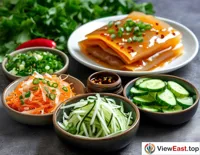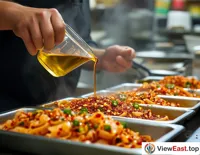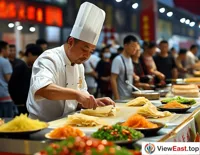







Part One: The Culture and Charm of Liang Pi
Liang Pi, a traditional snack originating from the northwest region of China, has become a staple on people's dining tables during the hot summer months with its unique texture and refreshing flavor. It is not just a dish but a miniature of the culinary culture of the northwest region.
Cultural Background:
The history of Liang Pi dates back to the Qin Dynasty, with a history of more than two thousand years. In places like Shaanxi, Gansu, and Ningxia, Liang Pi is an extremely popular traditional snack, especially in summer, where a bowl of Liang Pi can bring coolness and comfort to people.
Features:
The feature of Liang Pi lies in its unique production process and diverse condiment pairings. Made from rice or wheat flour, Liang Pi has a distinctive texture created through steaming and cooling. Combined with specially made chili oil, garlic paste, vinegar, and other seasonings, it retains the original flavor of the food while adding a rich layer of taste.
Taste and Texture:
Liang Pi has a fresh taste and a smooth, slightly elastic texture. The spiciness of chili oil, the tanginess of vinegar, and the freshness of garlic paste together form the unique flavor profile of Liang Pi.
Appearance:
Liang Pi has a translucent appearance. The wide strips of Liang Pi are paired with various colorful vegetable shreds, such as cucumber and carrot shreds, which not only add color but also nutrition.
Nutritional Value:
Made primarily from rice or wheat flour, Liang Pi is rich in carbohydrates, providing energy to the body. The accompanying vegetables provide vitamins and dietary fiber, making Liang Pi a healthy and delicious snack.
B: The Making Process of Liang Pi
Introduction to Ingredients:
Rice or wheat flour.
Seasonings: chili oil, garlic paste, vinegar, salt, sugar.
Cooking Tools:
Steamer.
Frying pan (for making seasonings).
Preparation of Ingredients:
Mix rice or wheat flour with water to form a paste.
Cooking Steps:
Spread the paste evenly into a steaming dish and steam until cooked. Remove and cool.
Cut the cooled Liang Pi into strips.
Prepare the seasonings by mixing chili oil, garlic paste, vinegar, salt, sugar, and other seasonings evenly.
Toss the Liang Pi with the seasonings and add shredded cucumber, carrot, and other vegetable shreds.
Seasoning Tips:
The preparation of chili oil is crucial and can be adjusted to your taste.
The choice of vinegar is also important, as different types of vinegar bring different flavors.
Serving Suggestions:
It's best to eat Liang Pi freshly made for the best texture.
It can be refrigerated before eating for an even more refreshing experience.